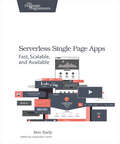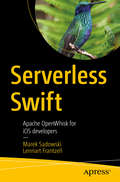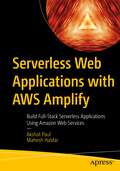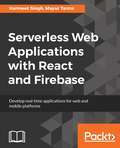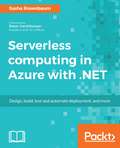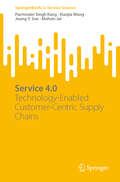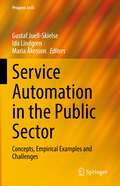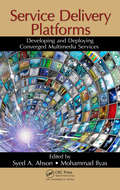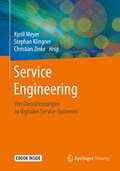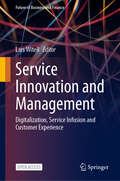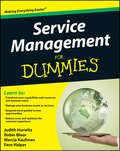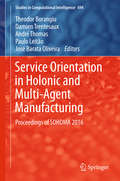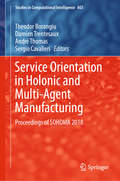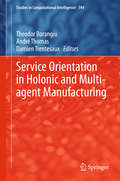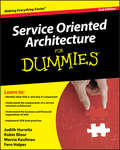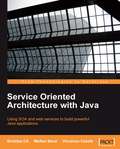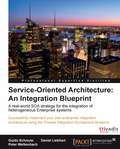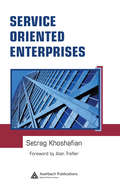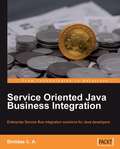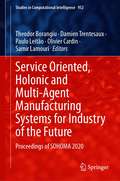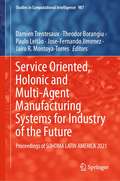- Table View
- List View
Serverless Single Page Apps: Fast, Scalable, and Available
by Ben RadyDon't waste your time building an application server. See how to build low-cost, low-maintenance, highly available, serverless single page web applications that scale into the millions of users at the click of a button. Quickly build reliable, well-tested single page apps that stay up and running 24/7 using Amazon Web Services. Avoid messing around with middle-tier infrastructure and get right to the web app your customers want.You don't need to manage your own servers to build powerful web applications. This book will show you how to create a single page app that runs entirely on web services, scales to millions of users, and costs less per day than a cup of coffee.Using a web browser, a prepared workspace, and your favorite editor, you'll build a complete single page web application, step by step. Learn the fundamental technologies behind modern single page apps, and use web standards to create lean web applications that can take advantage of the newest technologies. Deploy your application quickly using Amazon S3. Use Amazon Cognito to connect with providers like Google and Facebook to manage user identities. Read and write user data directly from the browser using DynamoDB, and build your own scalable custom microservices with Amazon Lambda.Whether you've never built a web application before or you're a seasoned web developer who's just looking for an alternative to complex server-side web frameworks, this book describes a simple approach to building serverless web applications that you can easily apply or adapt for your own projects.What You Need:To follow the tutorial in this book, you'll need a computer with a web browser. You'll also need a text editor and a git client. Building this web application will require some sort of development web server. You can use your own, or you can also use the one included with the tutorial's prepared workspace. The included web server requires Ruby 2.0, although we also suggest few alternatives. To get started quickly, you need a basic understanding of HTML, CSS, and JavaScript. If you're new to these topics, you can get up to speed using links we'll provide in the Introduction.
Serverless Swift: Apache OpenWhisk for iOS developers
by Marek Sadowski Lennart FrantzellDecrease development time to market with Serverless Swift—the event-based modern architecture for full stack developers. This book reviews how to use the Apache OpenWhisk framework to enrich your standalone applications with cloud-based functionalities from data sources up to Artificial Intelligence. You'll leverage serverless in your mobile apps with use case scenarios and gain the skills that will allow you to create robust, performant, secure yet economically viable systems in a cloud native environment. Finally, you'll see how to participate in the creation and further development of this open source project with Apache Foundation, which is supported by IBM, Google, and othersServerless has become a new style of coding, and it can be used to offload your mobile apps without incurring unnecessary costs. Get a solid, hands-on introduction into serverless, function-as-a-service, and cloud function technologies and learn why startups and enterprises are so excited about using them. What You'll LearnEmploy Apache OpenWhisk in your appsExpand your iOS skills with Cloud Native Serverless programmingUse a Docker container as a Polyglot actionWho This Book Is ForDevelopers, development leaders in the enterprise, and startup CTOs who want to learn a leading technology for the cloud in order to enrich applications with SaaS, Social Networks, and cloud based AI and APIs.
Serverless Web Applications with AWS Amplify: Build Full-Stack Serverless Applications Using Amazon Web Services
by Akshat Paul Mahesh HaldarLearn the fundamentals of serverless applications and how to take advantage of time-tested Amazon Web Services (AWS) to build scalable apps. This book shows you how to work with the key features of your applications with minimum code, simple CLI commands and one-click deployments. You'll see how to manage authentication, standard UI components, database storage, filesystem, CI/CD pipeline and more. You'll also examine the architecture, strengths, scalability, and limitations of serverless, and how to use AWS Amplify effectively. You will use tools including React, Cognito, GraphQL, DynamoDB, Kinesis, and Sagemaker. AWS Amplify is the fastest and easiest way to build serverless web and mobile apps at scale, comprising tools and services that work independently and can be wired together to build scalable apps. What You'll Learn Build GraphQL and REST APIsModel data with Amplify DatastoresSet up a CI/CD pipeline with AmplifyRecord and make sense of user data analytics with KinesisBoost your application with AI/ML capability using Sagemaker Who This Book Is ForDevelopers who have worked on web technologies and want to learn how to build serverless applications and developers interested in making powerful applications using AWS that can then be wired using AWS Amplify.
Serverless Web Applications with React and Firebase: Develop real-time applications for web and mobile platforms
by Harmeet Singh Mayur TannaBuild rich and collaborative applications using client-side code with React, Redux, and FirebaseKey Features1) A practical guide covering the full stack for web development with React 16 and Firebase2) Leverage the power of Firebase Cloud Storage, messaging, functions, OAuth, and database security to develop serverless web applications.3) Develop high-performance applications without the hassle of setting up complex web infrastructure.Book DescriptionReactJS is a wonderful framework for UI development. Firebase as a backend with React is a great choice as it is easy, powerful, and provides great developer experience. It removes a lot of boilerplate code from your app and allows you to focus on your app to get it out quickly to users. Firebase with React is also a good choice for Most Viable Product (MVP) development.This book provides more practical insights rather than just theoretical concepts and includes basic to advanced examples – from hello world to a real-time seat booking app and Helpdesk applicationThis book will cover the essentials of Firebase and React.js and will take you on a fast-paced journey through building real-time applications with Firebase features such as Cloud Storage, Cloud Function, Hosting and the Realtime Database. We will learn how to secure our application by using Firebase authentication and database security rules. We will leverage the power of Redux to organize data in the front-end, since Redux attempts to make state mutations predictable by imposing certain restrictions on how and when updates can happen. Towards the end of the book you will have improved your React skills by realizing the potential of Firebase to create real-time serverless web applications.What you will learnInstall powerful React.js and Firebase tools to make development much more efficientCreate React components with Firebase to save and retrieve the data in real-timeUse Firebase Authentication to make your React user interface secureDevelop React and Firebase applications with Redux integration Firebase database security rulesFirebase Cloud Storage Integration to upload and store data on the cloudCreate a complete real-time application with React and firebaseUsing Firebase Cloud messaging and Cloud functions with ReactFirebase Cloud Storage integration with ReactWho this book is forThis book is for JavaScript developers who have some previous knowledge of React and want to develop serverless, full-stack applications but without the hassle of setting up a complex infrastructure.
Serverless computing with Azure and .NET
by Sasha RosenbaumThis book is for .NET developers who would like to learn about serverless architecture. Basic C# programming knowledge is assumed.
Service 4.0: Technology-Enabled Customer-Centric Supply Chains (SpringerBriefs in Service Science)
by Parminder Singh Kang Xiaojia Wang Joong Y. Son Mohsin JatThis book presents a systematic framework for Service 4.0, including service digitization, digitalization, and digital transformation, which is an integral part of Supply Chain 4.0 in coping with complex, dynamic, and interdependent systems. It provides a comprehensive state-of-the-art review of digital technologies to support Service 4.0 and Supply Chain 4.0, and discusses important pillars of customer-centric supply chain models. It then explains the role of big data in customer-centric service-based supply chains and links the different types of data needed to promote end-to-end transparency and value co-creation activities to promote these key pillars. Moreover, the book introduces practical models to support analytics for customer-centric supply chains and sheds light on how the industry practically uses existing models to promote service co-creation. A chapter of a case study on women's clothing e-commerce reviews and demonstrates how various data visualization and text mining methods can be used to uncover meaningful insights within the review data. The book is intended to help students and researchers quickly navigate through various technologies and future research directions in the areas of Service 4.0 and Supply Chain 4.0. It is also a valuable read for practitioners in this field.
Service Automation in the Public Sector: Concepts, Empirical Examples and Challenges (Progress in IS)
by Ida Lindgren Gustaf Juell-Skielse Maria ÅkessonThis edited volume highlights the latest advances in and findings from research on service automation in public sector organizations. The contributing authors use a mix of social and technological approaches to increase readers’ understanding of public service automation. The respective chapters discuss the automation of services in public organizations from a conceptual standpoint, present empirical examples of automation applications in public organizations, and consider the implementation-related challenges that can arise. The book’s overall goal is to aid and inspire researchers and practitioners to expand their knowledge of service automation in public organizations, while also providing a foundation for policy development and future research. Following a brief introductory chapter, the book addresses major gaps in our current understanding of service automation in public organizations, and provides suggestions for future research. Moreover, it argues that there is a continued need to observe and learn from empirical examples, and a need for more critical studies on the social and societal consequences of increased service automation in public organizations.
Service Delivery Platforms: Developing and Deploying Converged Multimedia Services
by Mohammad Ilyas Syed A. AhsonIt is becoming increasingly important for telecom operators to be able to provide service delivery platforms (SDP) quickly and efficiently in order to improve the time-to-revenue of value-added services. Presenting a rapid architecture solution to meet this challenge, Service Delivery Platforms: Developing and Deploying Converged Multimedia Service
Service Design: From Insight to Implementation
by Andrew Polaine Lavrans Løvlie Ben ReasonService Design is an eminently practical guide to designing services that work for people. It offers powerful insights, methods, and case studies to help you design, implement, and measure multichannel service experiences with greater impact for customers, businesses, and society.
Service Engineering: Von Dienstleistungen Zu Digitalen Service-systemen
by Kyrill Meyer Stephan Klingner Christian ZinkeDas Buch beleuchtet aktuelle Herausforderungen des Service Engineerings und zeigt dessen Entwicklung im Kontext digitaler Service-Systeme sowie Chancen und Möglichkeiten, die digitale Dienstleistungsangebote und vernetzte Lösungen bieten. Wissenschaftliche Ausführungen werden durch praxisorientierte Beispiele, welche die Anwendung der Lösungsansätze und Methoden demonstrieren, ergänzt. Damit betrachten die Autoren dieses Sammelbands einerseits die Evolution der systematischen Dienstleistungsentwicklung in Theorie und Praxis und stellen andererseits aktuelle Forschungsthemen und Entwicklungstendenzen vor. Dazu ziehen die Herausgeber Arbeiten der Partner des Forschernetzwerkes FOKUS Service Engineering heran. Die Beiträge sprechen sowohl Wissenschaftler als auch Vertreter der Praxis an.
Service Innovation and Management: Digitalization, Service Infusion and Customer Experience (Future of Business and Finance)
by Lars WitellThis open access book investigates how digitalization and service infusion are changing service provision and the customer experience. It highlights the central role of service management and service innovation in making these changes not only appear in theory but also implementing them in business practice. At the beginning of the 21st century, many manufacturing firms struggled to exploit the financial potential of service businesses, a phenomenon described as the service paradox. While many manufacturing firms are still struggling with this paradox, several firms (both service and manufacturing firms) are simultaneously struggling with digitalization. This phenomenon can be viewed as the digitalization paradox, i.e., as a situation in which companies invest in digitalization but struggle to reach the expected revenue growth. By applying the lens of service innovation to digitalization and service infusion, the book showcases how firms can overcome the service and digitalization paradoxes, transform service provision, and improve the customer experience. It offers comprehensive coverage, blending literature reviews, conceptualizations, empirical illustrations, and case studies to offer a multifaceted perspective on corporate strategies, illuminating pathways to address the challenges posed by the service and digitalization paradoxes. Built on the latest research from the CTF – Service Research Center at Karlstad University, Sweden, this book offers a valuable resource for managers seeking practical strategies and approaches to enhance their understanding and implementation of service management and marketing principles. It will also appeal to academics with an interest in service management and marketing.
Service Level Management in Emerging Environments
by Nader MbarekNetworks are now embedded in daily life thanks to smaller, faster, inexpensive components that are more powerful and increasingly connected. Parallel to this quantitative explosion of communication networks, technology has become more complex. This development comes with challenges related to management and control, and it has become necessary to manage the service level demands of the client to which the service provider commits. Different approaches to managing one or more service level components in different emerging environments are explored, such as: the Internet of Things, the Cloud, smart grids, e-health, mesh networking, D2D (Device to Device), smart cities and even green networking. This book therefore allows for a better understanding of the important challenges and issues relating to Quality of Service (QoS) management, security and mobility in these types of environment.
Service Management For Dummies
by Marcia Kaufman Fern Halper Robin Bloor HurwitzA plain-English guide to managing IT from the customer's perspectivePractical guidance on delivering and managing IT so that it meets the multiple needs and demands of a company and its customers and end-users-both inside and outside the organization-is hard to come by; this accessible book takes a common-sense approach that explains exactly what IT services are and how to fit them most effectively into a businessTopics include setting a framework, keeping costs down, improving efficiency, and maintaining standards and best practicesThis concept of how IT should be wired specifically into the goals and need of the company and its customers is part of a broader picture that includes ITIL, BPM, SOA, and Six Sigma
Service Orientation in Holonic and Multi-Agent Manufacturing
by Theodor Borangiu André Thomas Damien Trentesaux Paulo Leitão José Barata OliveiraThis volume gathers the peer reviewed papers presented at the 4th edition of the International Workshop "Service Orientation in Holonic and Multi-agent Manufacturing - SOHOMA'14" organized and hosted on November 5-6, 2014 by the University of Lorraine, France in collaboration with the CIMR Research Centre of the University Politehnica of Bucharest and the TEMPO Laboratory of the University of Valenciennes and Hainaut-Cambr#65533;sis. The book is structured in six parts, each one covering a specific research line which represents a trend in future manufacturing: (1) Holonic and Agent-based Industrial Automation Systems; (2) Service-oriented Management and Control of Manufacturing Systems; (3) Distributed Modelling for Safety and Security in Industrial Systems; (4) Complexity, Big Data and Virtualization in Computing-oriented Manufacturing; (5) Adaptive, Bio-inspired and Self-organizing Multi-Agent Systems for Manufacturing and (6) Physical Internet Simulation, Modelling and Control. There is a clear orientation of the SOHOMA'14 workshop towards complexity, which is a common view of all six parts. There is need for a framework allowing the development of manufacturing cyber physical systems including capabilities for complex event processing and data analytics which are expected to move the manufacturing domain closer towards cloud manufacturing within contextual enterprises. Recent advances in sensor, communication and intelligent computing technologies made possible the Internet connectivity of the physical world: the Physical Internet, where not only documents and images are created, shared, or modified in the cyberspace, but also the physical resources and products interact over Internet and make decisions based on shared communication.
Service Orientation in Holonic and Multi-Agent Manufacturing
by Theodor Borangiu André Thomas Damien Trentesaux Olivier CardinThis volume gathers the peer reviewed papers presented at the 4th edition of the International Workshop "Service Orientation in Holonic and Multi-agent Manufacturing - SOHOMA'14" organized and hosted on November 5-6, 2014 by the University of Lorraine, France in collaboration with the CIMR Research Centre of the University Politehnica of Bucharest and the TEMPO Laboratory of the University of Valenciennes and Hainaut-Cambr#65533;sis. The book is structured in six parts, each one covering a specific research line which represents a trend in future manufacturing: (1) Holonic and Agent-based Industrial Automation Systems; (2) Service-oriented Management and Control of Manufacturing Systems; (3) Distributed Modelling for Safety and Security in Industrial Systems; (4) Complexity, Big Data and Virtualization in Computing-oriented Manufacturing; (5) Adaptive, Bio-inspired and Self-organizing Multi-Agent Systems for Manufacturing and (6) Physical Internet Simulation, Modelling and Control. There is a clear orientation of the SOHOMA'14 workshop towards complexity, which is a common view of all six parts. There is need for a framework allowing the development of manufacturing cyber physical systems including capabilities for complex event processing and data analytics which are expected to move the manufacturing domain closer towards cloud manufacturing within contextual enterprises. Recent advances in sensor, communication and intelligent computing technologies made possible the Internet connectivity of the physical world: the Physical Internet, where not only documents and images are created, shared, or modified in the cyberspace, but also the physical resources and products interact over Internet and make decisions based on shared communication.
Service Orientation in Holonic and Multi-Agent Manufacturing: Proceedings Of Sohoma 2017 (Studies in Computational Intelligence #762)
by Theodor Borangiu André Thomas Damien Trentesaux Sergio CavalieriThis book gathers the peer-reviewed papers presented at the 8th edition of the International Workshop “Service Orientation in Holonic and Multi-Agent Manufacturing – SOHOMA’18” held at the University of Bergamo, Italy on June 11–12, 2018. The objective of the SOHOMA annual workshops is to foster innovation in smart and sustainable manufacturing and logistics systems by promoting new concepts, methods and solutions that use service orientation of agent-based control technologies with distributed intelligence.Reflecting the theme of SOHOMA’18: “Digital transformation of manufacturing with agent-based control and service orientation of Internet-scale platforms”, the research included focuses on how the digital transformation, as advocated by the “Industry 4.0”, “Industrial Internet of Things”, “Cyber-Physical Production Systems” and “Cloud Manufacturing” frameworks, improves the efficiency, agility and sustainability of manufacturing processes, products, and services, and how it relates to the interaction between the physical and informational worlds, which is implemented in the virtualization of products, processes and resources managed as services.
Service Orientation in Holonic and Multi-agent Manufacturing
by Theodor Borangiu André Thomas Damien TrentesauxThis volume gathers the peer reviewed papers presented at the 4th edition of the International Workshop "Service Orientation in Holonic and Multi-agent Manufacturing - SOHOMA'14" organized and hosted on November 5-6, 2014 by the University of Lorraine, France in collaboration with the CIMR Research Centre of the University Politehnica of Bucharest and the TEMPO Laboratory of the University of Valenciennes and Hainaut-Cambrésis. The book is structured in six parts, each one covering a specific research line which represents a trend in future manufacturing: (1) Holonic and Agent-based Industrial Automation Systems; (2) Service-oriented Management and Control of Manufacturing Systems; (3) Distributed Modelling for Safety and Security in Industrial Systems; (4) Complexity, Big Data and Virtualization in Computing-oriented Manufacturing; (5) Adaptive, Bio-inspired and Self-organizing Multi-Agent Systems for Manufacturing and (6) Physical Internet Simulation, Modelling and Control. There is a clear orientation of the SOHOMA'14 workshop towards complexity, which is a common view of all six parts. There is need for a framework allowing the development of manufacturing cyber physical systems including capabilities for complex event processing and data analytics which are expected to move the manufacturing domain closer towards cloud manufacturing within contextual enterprises. Recent advances in sensor, communication and intelligent computing technologies made possible the Internet connectivity of the physical world: the Physical Internet, where not only documents and images are created, shared, or modified in the cyberspace, but also the physical resources and products interact over Internet and make decisions based on shared communication.
Service Oriented Architecture (SOA) For Dummies
by Marcia Kaufman Fern Halper Robin Bloor HurwitzFeeling overwhelmed by the buzz about SOA--service oriented architecture? Take heart! Service Oriented Architecture For Dummies, 2nd Edition makes it easy to understand, plan, and implement the latest SOA solutions for your business.Whether you're the IT person responsible for developing SOA or the executive who's trying to get a handle on the concept, Service Oriented Architecture For Dummies, 2nd Edition will help you understand what SOA is, why it's important, and how you can make the most of it. You'll find out about the business and financial aspects of SOA, how to decide if you need it, and what it can mean to your bottom line. Discover how to:Identify the main components of SOA and how they work to create business processesCreate reusable, flexible systems and avoid common pitfallsDeconstruct business processes and applications to identify their components, then put them together in new waysConstruct SOA business applications for maximum adaptabilityConfirm quality in a situation that's difficult to test, and assure the quality and consistency of your dataDevelop a governance strategy for SOA based on your company's philosophy and cultureWork with XML and understand how it's used in SOAMaximize the benefits of unified communicationsUnderstand software ecosystems, rich interfaces, and the development lifecyclePacked with real-life case studies illustrating how SOA has been applied in a variety of industries, Service Oriented Architecture For Dummies, 2nd Edition demystifies one of today's hottest business tools.
Service Oriented Architecture with Java
by Binildas A. Christudas Malhar BaraiThis book is an overview of how to implement SOA using Java with the help of real-world examples. It briefly introduces the theory behind SOA and all the case studies are described from scratch. This book is for Java programmers or architects who are interested in implementing SOA concepts in their applications. Readers should be familiar with Java Enterprise concepts.
Service Oriented Architecture: An Integration Blueprint
by Guido Schmutz Peter WelkenbachA theoretical guide, this book provides detailed and structured explanations and visualizations of the Trividas Integration Architecture Blueprint, showing you the strategy to implement your own integration projects. It draws on real-world integrations at an architectural level, and explores both product-neutral and specific integration scenarios. If you are an IT architect or manager who is responsible for any aspect of operating integration solutions, and you want to learn how to implement integration architectures in practice with the help of the Trivadis Integration Architecture Blueprint, then this book is for you. A comprehensive understanding of SOA is required, though previous knowledge of the Trivadis Blueprint is not necessary. Less experienced specialists who have not yet dealt with integration will benefit greatly from this book by first gaining knowledge of concepts and terminology used in the context of integration architecture, while those already familiar with such expertise can move straight to discovering the base technologies associated with implementing solutions based on the Blueprint, and getting to grips with the Blueprint's structure itself. If you want to assess the solutions from different vendors and ultimately achieve comprehensive SOA integration results using the Trivadis Integration Architecture Blueprint, then this book is ideal for you.
Service Oriented Enterprises
by Setrag KhoshafianExtending beyond the technical architecture to the very philosophy of how a business should operate, the Service Orientation approach establishes fluidity across boundaries to provide agility, transparency, and fundamental competitive advantage. Service Oriented Enterprises brings the concept of service orientation from the IT department to the boardroom, applying the precepts of service oriented technology to the underlying dynamics of how a business operates. Implementing a technological concept as a cultural paradigm, the SOE succeeds by combining the best features from virtual, extended, real-time, and resilient enterprises to serve not just its customers, but also its trading partners, shareholders and employees. Building primarily on the success of the Internet and the automation of business policies and processes, the Service Oriented Enterprise (SOE) is defined by three essential layers: the enterprise performance layer, the business process management layer, and the underlying service oriented architecture. This book focuses primarily on layers two and three and how the fundamental dynamics of a business can be altered when these concepts are applied to both architecture and culture. Beginning with an overview of the emerging SOE culture, the text contrasts the new service-oriented methodologies with traditional waterfall and iterative methodologies. Emphasizing Web Service strategies for description, discovery, and deployment techniques, the author goes deeper into service-oriented concepts describing the business process management suite as the central core of the SOE, and introducing the Enterprise Service Bus as the backbone for integration. The text describe how modeling, executing, and continuously improving the business process and business policies lends to the development of a common language between business and IT. The book concludes by expanding on these concepts and delving into the societal and behavioral aspects of the Service Oriented Enterprise.The reality of business is no longer one where change is an unusual phenomenon; today change is the norm and the capacity for consumer-sensitive, fluid transition is vital to business survival. Service Oriented Enterprises provides the key concepts to facilitate that change.
Service Oriented Java Business Integration
by Binildas A. ChristudasThe book covers all concepts with examples that can be built, deployed, and run by readers using the Apache Ant tool in Apache ServiceMix, which is an open-source Enterprise Service Bus that combines the functionality of a Service Oriented Architecture (SOA) and an Event Driven Architecture (EDA). The aim of this book is to prepare an architect or developer for building integration solutions using ESB. To that end, this book takes a practical approach, emphasizing how to get things done in ServiceMix with code. When needed, it delves into the theoretical aspects of ESB, and such discussions are supplemented with working samples. The book, thus, distils some of the knowledge that has emerged over the last decade in the realm of Java Integration. This book is aimed at Java developers and integration architects who want to become proficient with the Java Business Integration (JBI) standard. Readers should have some experience with Java and have developed and deployed applications in the past, but need no previous knowledge of JBI. The book can also be useful to anyone who is struggling to understand ESB and how it differs from other architectures and to understand its position in SOA. This book primarily targets IT professionals in the field of SOA and Integration solutionsâ "in other words, intermediate to advanced users. You are likely to find the book useful if you fall into any of the following categories: A programmer, designer, or architect in Java who wants to learn and code in JBI or ESB. A programmer, designer, or architect who doesn't normally code in Java can still benefit from this book, since we 'assemble integration components' using XML with little to no Java code. An IT Manager or an Officer who knows well about SOA or SOI but want to see something in code (you can adorn your flashy presentations with some live code too).
Service Oriented, Holonic and Multi-Agent Manufacturing Systems for Industry of the Future: Proceedings of SOHOMA 2020 (Studies in Computational Intelligence #952)
by Theodor Borangiu Damien Trentesaux Paulo Leitão Olivier Cardin Samir LamouriThe scientific theme of the book concerns “Manufacturing as a Service (MaaS)” which is developed in a layered cloud networked manufacturing perspective, from the shop floor resource sharing model to the virtual enterprise collaborative model, by distributing the cost of the manufacturing infrastructure - equipment, software, maintenance, networking - across all customers.MaaS is approached in terms of new models of service-oriented, knowledge-based manufacturing systems optimized and reality-aware, that deliver value to customer and manufacturer via Big data analytics, Internet of Things communications, Machine learning and Digital twins embedded in Cyber-Physical System frameworks. From product design to after-sales services, MaaS relies on the servitization of manufacturing operations such as: Design as a Service, Predict as a Service or Maintain as a service.The general scope of the book is to foster innovation in smart and sustainable manufacturing and logistics systems and in this context to promote concepts, methods and solutions for the digital transformation of manufacturing through service orientation in holonic and agent-based control with distributed intelligence.The book’s readership is comprised by researchers and engineers working in the manufacturing value chain area who develop and use digital control solutions in the ‘Industry of the Future’ vision. The book also addresses to master and Ph.D. students enrolled in Engineering Sciences programs.
Service Oriented, Holonic and Multi-Agent Manufacturing Systems for Industry of the Future: Proceedings of SOHOMA 2023 (Studies in Computational Intelligence #1136)
by Theodor Borangiu Damien Trentesaux Paulo Leitão Lamia Berrah Jose-Fernando JimenezThe scientific theme of the book is “Sustainability for the digital manufacturing era” which is focused on how the technological enablers of digital systems drive the sustainability for products, processes, manufacturing, and logistics systems in the industry of the future. The book’s chapters describe sustainability drivers specific to the technological advances that motivate, encourage, and engage the economic, social, and environmental aspects within intelligent manufacturing and logistics systems. The novelty of this approach consists in extending the economic sustainability of digital manufacturing with the ethical perspective at human social scale. The general scope of the book is to foster innovation in smart and sustainable manufacturing and logistics systems and in this context to promote concepts, methods, and solutions for the digital transformation of manufacturing through service orientation in holonic and agent-based control with distributed intelligence. The book’s readership is comprised of researchers and engineers working in the value chain of products and processes, who develop digital control solutions in the “Industry of the Future” vision. The book is also addressed to master’s and Ph.D. students enrolled in Engineering Sciences programs.
Service Oriented, Holonic and Multi-Agent Manufacturing Systems for Industry of the Future: Proceedings of SOHOMA LATIN AMERICA 2021 (Studies in Computational Intelligence #987)
by Theodor Borangiu Damien Trentesaux Paulo Leitão Jose-Fernando Jimenez Jairo R. Montoya-TorresThis book approaches its subject matter by promoting concepts, methods and solutions for the digital transformation of manufacturing through service orientation in holonic and agent-based control with distributed intelligence. The scientific theme of the book concerns “Manufacturing as a Service”, developed by virtualizing and encapsulating manufacturing resources, activities and controls into cloud networked services in an open perspective that spans models from shop floor resource allocation to enterprise infrastructure sharing. The papers included in the application space have a profound human dedication and aim at solving societal needs serving the partnership of the future—people and industry in the era of Society 5.0. The book’s readership includes researchers and engineers working in manufacturing, supply chains and logistics areas who innovate, develop and use digital control solutions and students enrolled in Engineering and Service Science programs.
